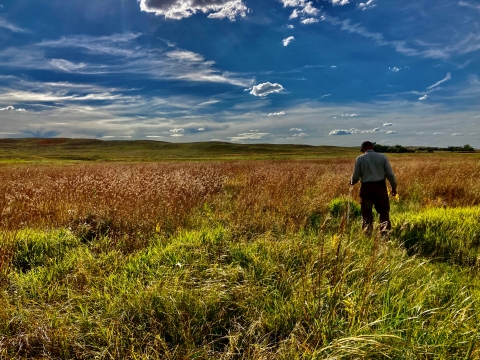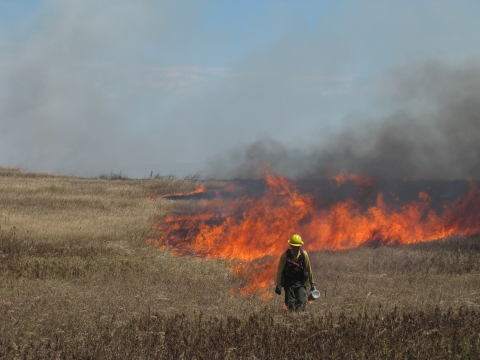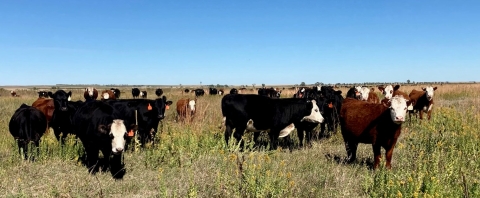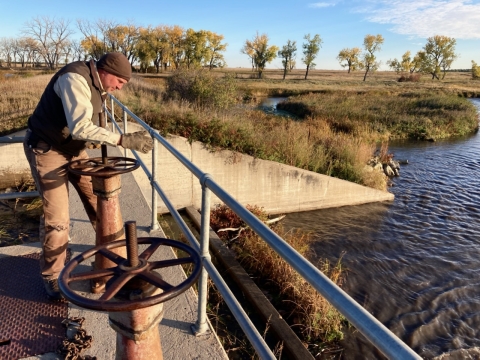What We Do
Lacreek National Wildlife Refuge staff relies on current science to guide wildlife and habitat management in addressing existing and future challenges. Refuge staff uses prescribed fire, livestock grazing, prairie restoration and water management to provide optimum habitat for migrating birds and numerous mammals. The Refuge also has a prairie dog control program to confine populations to Refuge property and off of private land. In addition, the Refuge provides recreational opportunities including bird watching, fishing, hunting, and hiking.
Management and Conservation
Lacreek National Wildlife Refuge staff use a number of methods that create a positive effect on habitat over time. Using a pattern of prescribed fire, grazing, flooding, rest and water management, Refuge staff are able to create shelter, food and resting and nesting grounds for migrating birds. Beaver and muskrat are allowed to engage in their usual activities unless they threaten a critical levee or water control structures. We do our best to let wildlife be!
The Comprehensive Conservation Plan sets the course of management and use of Lacreek National Wildlife Refuge.
Fire Management
Fire, whether human-caused or started by lightning, has been a part of the prairie ecosystem for thousands of years. Grasslands of the Northern Great Plains evolved under periodic disturbance from bison and fire. This periodic disturbance kept the grasslands healthy for thousands of years and is needed to keep them healthy today. Lacreek NWR is located in a mixed-grass ecosystem, an area which has been subjected to the effects of fire for centuries. The historical fire frequency on the mixed grass prairie is believed to be once every 5 to 7 years.
Historic records describe huge prairie fires started by lightning or humans. Reports of early accounts by explorers viewed prairie wildfires as a feeling of danger, a risk, and a spectacle. Lightning caused fires were common in the United States and Canada; however, fires set by native peoples were the type mentioned most often in historical journals, diaries, and various other accounts. Throughout the area, the Lakota Sioux set fire to the prairie to provide lush new growth to attract bison.
Fire constitutes one of the most important ecological processes of the prairie ecosystem. Fire may have short-term effects while yielding long-term positive effects. Fire exposes the soil to sunlight, increases soil temperatures and lengthens the growing season. It kills or reduces some plants and stimulates and invigorates native plants. Fire quickly cycles nutrients in a prairie by converting plant litter and standing growth to ash, which is absorbed into the soil and made available for plants.
The Refuge has used prescribed fire for many years to manage resources and reduce the amount of dead vegetation. From 1969 to 1997, the Refuge conducted 26 burns for a total of 3,453 acres. This is an average of less than one burn per year. In 1997, Refuge staff expanded the prescribed fire program and increased the use of prescribed fire to maintain healthy grasslands. Since 1997, over 40,000 acres have been treated with fire. Fire may also be used to manage wetland communities. In the case of wetlands, heavy wetland vegetation is burned and then reflooded, which results in increased use by waterfowl and shorebirds.
Invasive Species Management
Refuge staff control non-native vegetation to restore diversity to habitats. A variety of non-native species including leafy spurge (Euphorbia esula), perennial sow thistle (Sonchus arvensis), and purple loosestrife (Lythrum salicaria) are currently being managed at the Refuge; however, the most troublesome species is Canada thistle (Cirsium arvense). Canada thistle, a native to Europe, is believed to have been introduced into North America during the early 17th century. It has since spread throughout much of the central and northern United States and has become a noxious weed in grasslands.
Multiple approaches are used to control Canada thistle including grazing, prescribed fire, herbicides and water management. While control of Canada thistle is ongoing, management has shifted towards restoring plant communities to include a diversity of species that can out-compete non-native species. To improve issues with non-native species, Refuge staff look for long-term solutions supported by science when restoring grasslands using seeding and well-timed prescribed fire.
Prescribed Grazing
Historically, the prairies and marshes evolved under wildfire and grazing from large mammals like bison and elk. Today, cattle and carefully controlled prescribed fire are used to mimic those historic processes. Prescribed grazing can be used to encourage the lush growth of grasses in which waterfowl and other grassland birds prefer to nest. Grazing stimulates the grass growth, returns nutrients to the soil, and removes dead plant material, which can create unhealthy grasslands. Properly timed grazing can also be used to control non-native grasses which are not desirable for nesting cover.
Prairie Reconstruction
Historically, farmers plowed and planted crops on many areas now within the Refuge boundary. This eliminated the native plant communities that existed. Refuge staff believe that re-establishing and maintaining diverse native plant communities provides the best long term and sustainable solution to providing wildlife habitat on the Refuge. Native plant communities are well adapted to changes in climate that occur from year to year and respond favorably to prescribed fire, grazing, and changes in water levels. Diverse native plant communities are more resistant to invasive species invasive species
An invasive species is any plant or animal that has spread or been introduced into a new area where they are, or could, cause harm to the environment, economy, or human, animal, or plant health. Their unwelcome presence can destroy ecosystems and cost millions of dollars.
Learn more about invasive species , and they provide the habitat requirements needed by grassland birds.
A prairie reconstruction program began in 2001 with approximately 500 acres of existing crop fields planted with five to seven species of native grasses. In 2004, Refuge staff began the process of converting over 5,000 additional acres of non-native grasses like crested wheatgrass, smooth brome, and Kentucky bluegrass to a more diverse native plant community. We have found that farming an area for four or five years is needed to eliminate the extensive root systems of smooth brome and Canada thistle. On areas that were not cropland but heavily invaded native prairie, staff used herbicides to remove the non-native species for three successive years. Once the undesirable non-native species have been removed from the area, inter-seeding the area with native species can begin.
In wetter sites, the new plants establish quickly while the drier sites take more time to become established. Typically, annual weeds are to be expected early in a new reconstruction. The perennial native plants put much of their initial energy into growing root systems, allowing the annual plants to dominate the above-ground space. As the native plants develop stronger root systems, they begin to suppress the growth of the annual plants, eventually dominating the site. While it is not possible to duplicate the incredible diversity found on native prairie areas that have never been disturbed by the plow, efforts are made to achieve as much plant diversity as possible.
Wetland Management
Many wetlands that appear dry during the summer drawdowns are actually covered by very shallow water. Properly managed, these areas grow species such as spike rush that support abundant insect populations. Many species of birds, such as Virginia and sora rails, Wilson's phalaropes, white-faced Ibis, marbled godwits, willets, blue-winged teal, and northern shovelers find this ideal habitat for raising their young.
The Refuge has 13 water impoundments creating nearly 5,400 acres of shallow flooded marsh and open water habitat. Water levels can be raised or lowered in each impoundment through water control structures. This is one of the most effective ways to manage water levels for migratory birds. Perennial flow of water coming onto the Refuge via Lake Creek, Cedar Creek, and Elm Creek coupled with the water control structures allow water management to create conditions within wetlands so that seeds from wetland plants (mostly annuals) can germinate, grow, and set seed.
Water levels are slowly dropped beginning in late March and continue through early May. These drawdowns encourage vegetation growth and seed production. In addition to the timing, how fast the water is lowered is important in determining which plants will grow. These drawdowns are conducted at a gradual rate creating exposed mudflats that provide quality food for migrating birds, especially shorebirds. As the summer season draws to a close, usually in early September, shallow water is added to the units to provide food for migrating waterfowl.
Wetland vegetation like arrowhead, produced during the summer months, serve as an important food source for wintering trumpeter swans utilizing the Refuge. During the summer drawdowns, arrowhead and soft stem bulrush often establish and grow on portions of the pools. The arrowhead grows very large leaves which capture the summer sun and store this energy in underground tubers (roots), which are similar to small potatoes. When freezing temperatures return, the above ground stems freeze off and create open water again. The underground tubers remain and provide the most preferred natural foods for Trumpeter swans. The bulrush roots and stems are a preferred food and lodge building material for muskrats.
Population Monitoring
Refuge biologists conduct wildlife and plant monitoring that guides and supports refuge management. Grouse numbers are monitored using spring lek (courting grounds) counts and hunter harvest information. Waterfowl nesting success is evaluated by conducting duck pair and brood counts in the spring. Bald eagle nests on and adjacent to the Refuge are observed and the number of young noted. Breeding bird and amphibian call surveys are run along established routes each spring. Grassland health is evaluated with numerous transects that measure the height, density, and types of plant species. These and other wildlife and habitat monitoring efforts provide valuable information needed to better manage Refuge habitats.






